With FTTP now available to order to most of Lymm, this page gives some background / pointers to the available options for broadband in & around the area.
Lymm, Warburton and High Legh appear to have FTTP available to most addresses as at early 2023, though some areas are still to be delivered (Cherry Corner - looking at you...)
If you are unable to get FTTP and get low data rates on ADSL or FTTC then it's worth considering the "Fibre to the Mast" or FTTM from Vispa, some details also below.
Also check for Virgin Media fibre (new in late 2023), can be available in areas that OpenReach don't supply fibre to yet.
If you are interested in changing your service, a good place to start without any marketing is the Ofcom website, which shows what services may be available to your property, and what data rate you should expect.
Moneysavingexpert.com independently lists the best current deals (& are clear where they receive a commission) based on price and customer service surveys.
FTTP (Fibre to the Premises) aka "Ultrafast broadband"
The latest generation of broadband for most involves direct optical fibre into the premise, removing the reliance on copper cables - definitely the preferred option if available.
OpenReach based installation (from point of ordering FTTP) appears to take around three weeks or less as at October 2023.
New Broadband orders (moving house into Lymm etc)
Since August 2022 copper based broadband has been on Stop Sell - e.g. not available where Fibre IS available. This is causing minor disruption for new tenancies / house purchases, as a new broadband activation request typically needs new fibre installing, with the ~three week lead time. The top tip seems to be to order as soon as you possibly can, and if internet access is 'critical' then consider the BT offering that offers a mobile broadband service if your Fibre connection is not working - there are reports that this can be offered the day after the order is placed (best check before ordering though...)
Delivery is a two step process, though both steps are done on the same day now. First step - a new cable is run from the nearest junction (a pole for most people), to a new point on your house. This is terminated via a small grey box, close to ground level
OpenReach FTTP outdoor termination / junction box
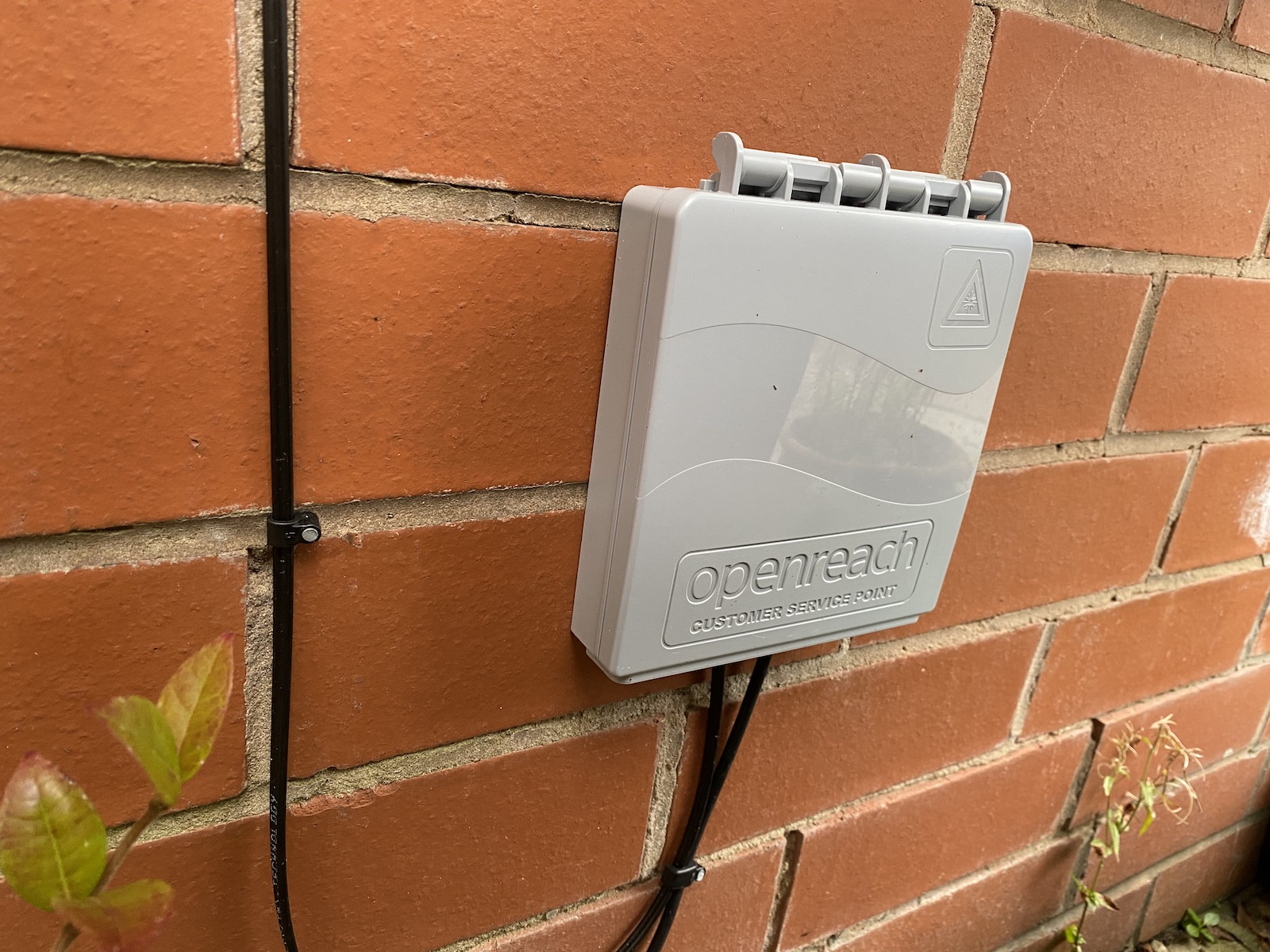
This is typically installed on the front of the property (e.g. facing the road / street pole), but can be terminated on the side of your property - these tend to be installed around 4 bricks above ground level. The cable to the left is the vertical fibre cable drop, coming from a pole in this instance. The fibre that goes inside the property can be seen as a second cable exiting the bottom of the grey box.
The second step runs a fibre cable from this grey box, into your house, and bring the service up. The fibre is run from inside the house to the outside - e.g. a bare cable that is a few mm in diameter is run through the wall, and connected to the new grey box outside - this can be passed through a small conduit / hole (may use the hole occupied by the incumbent copper cable). Apparently this cable is ok to have tight / small radius bends...(! - this could impact overall connection speeds, which the installer should check)
Likely the old copper line will be removed at this point - any broadband outage should be short - up to an hour, or could be zero (if the new line is brought up before the old line is removed). OpenReach will provide a new fibre termination box - an ONT - this needs to be mains powered (and no longer come with a backup battery by default), this connects into your existing or new router and the new incoming fibre
ONT (fibre termination / junction to copper ethernet)
the LOS light - not lit below is for "Loss Of Service"! The LAN light should flicker, mostly on.
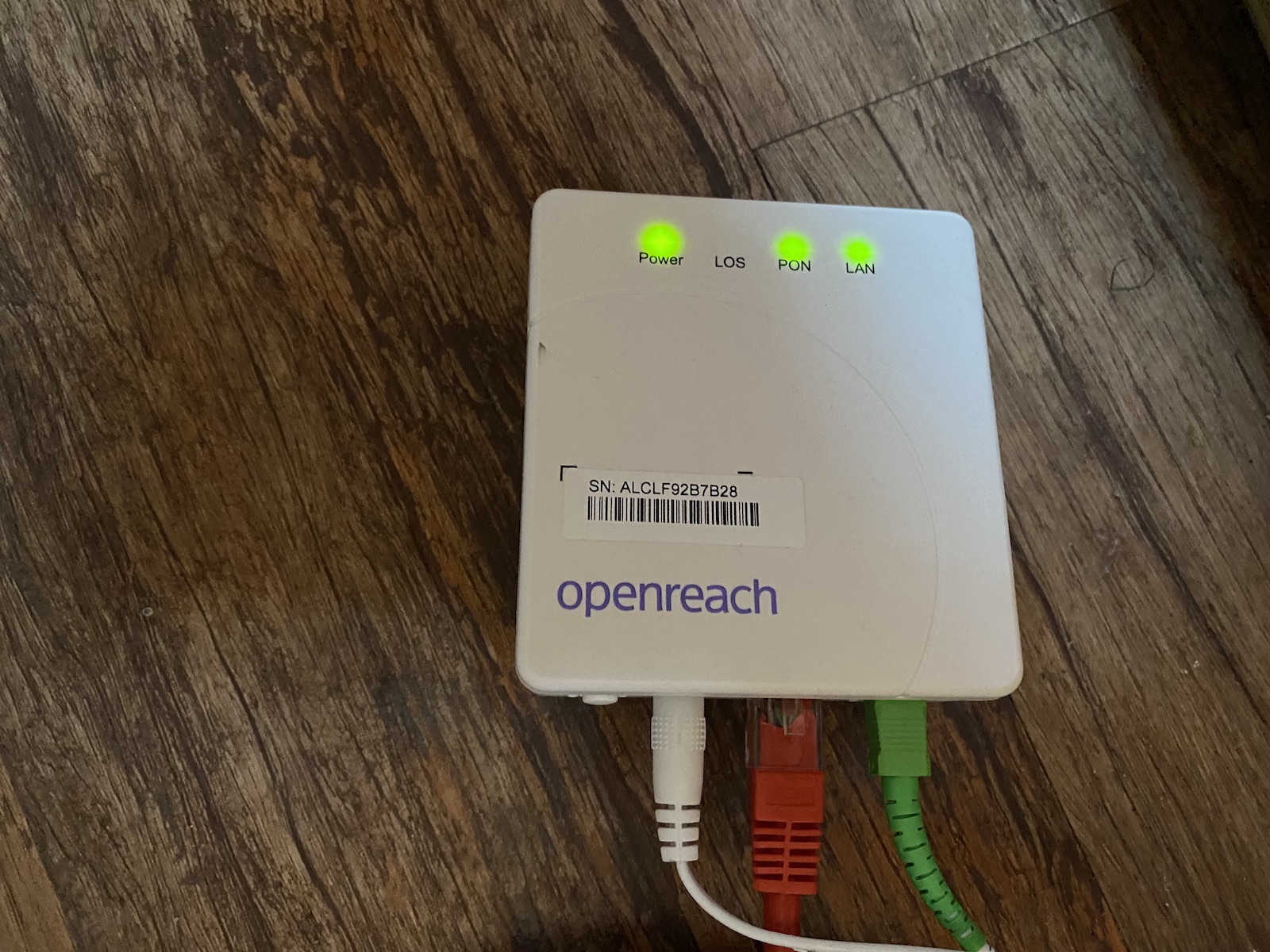
The connections from the above ONT are from left to right (above)
- Mains power (white)
- Ethernet cable to router (red)
- Incoming fibre from the grey box outside the property (green / white cable)
To find out whether FTTP is available to a given property you should check your phone number with a provider that offers FTTP (not all do...), or check on the BT Wholesale Availability checker (does not matter if you are with a different provider, it's a good checker to use due to the information given & is not going to try to sell you anything), ideally with your phone number, else or address. You will have to fill in the annoying Captcha.
If this does not work (it seems to be 'unavailable' at lot at the moment - best time to try is during a weekday), then try the checkers of one of the services that definitely offer FTTP - BT, Sky or Zen.
FTTP available looks like this (fifth line down: "WBC FTTP"):
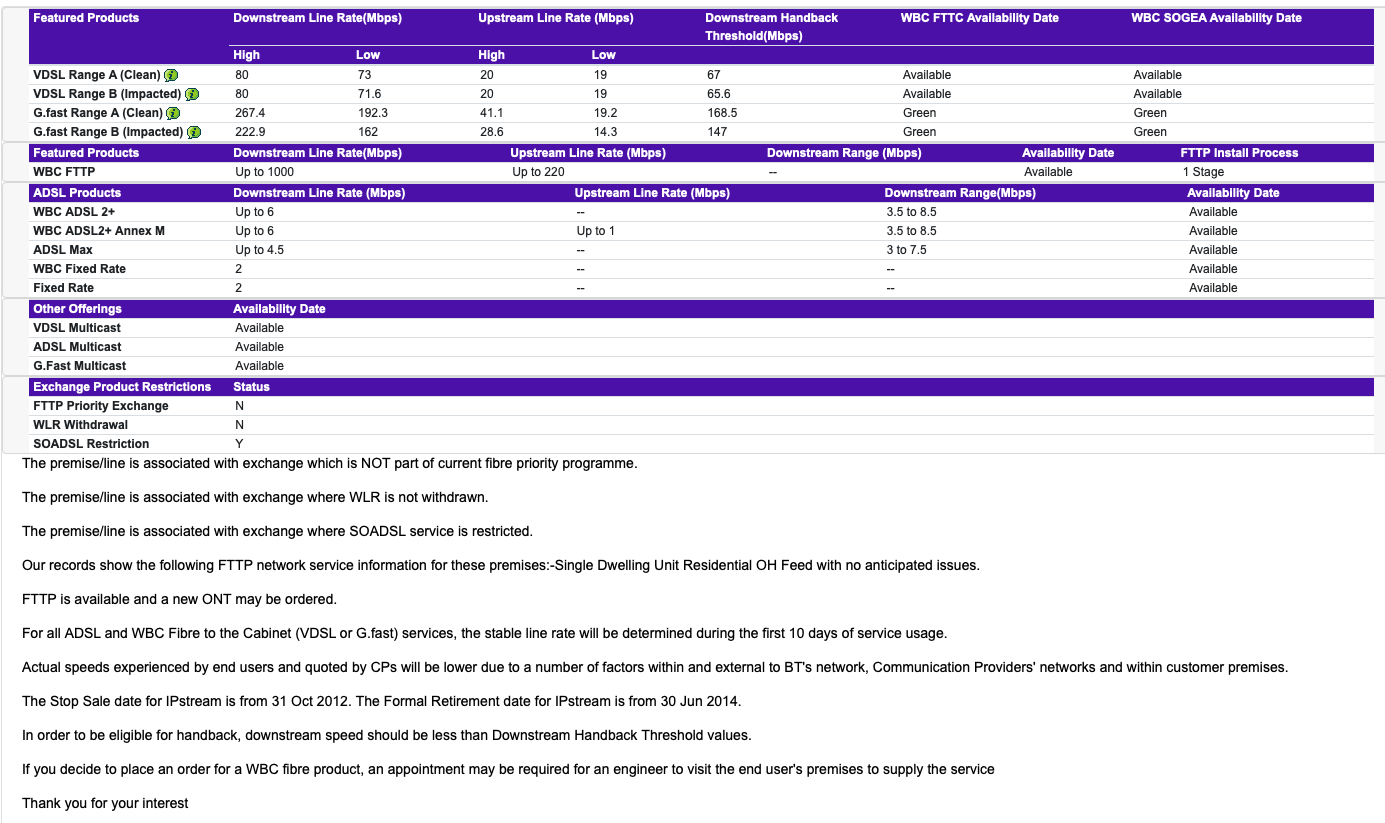
Example - where FTTP NOT yet available
& contrast the above with a circuit where FTTP is not available (though likely coming soon), where the third product line from the top states "FTTP on Demand" - the same end product, but several extra £000's for installation costs).
Note that below the FTTP on Demand product is available at 1,000 / 220 speeds - typically for Lymm this (FTTP on demand product 'was' available at 330 / 20 speeds (330Mbps download, 30 Mbps upload), suggesting this property will soon have FTTP available to order, and "WBC FTTP" will displace the "FTTP on Demand product":
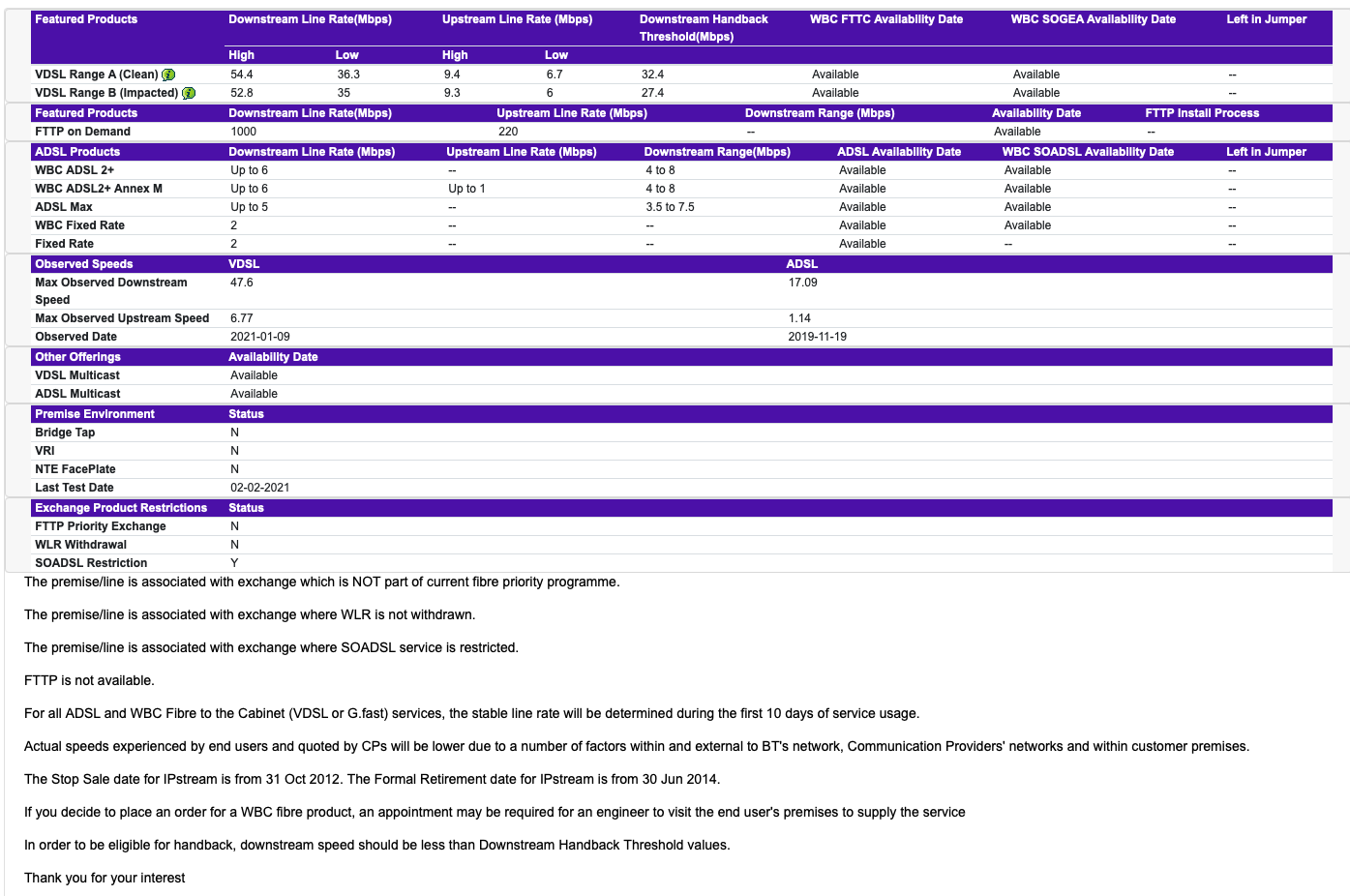
Providers that offer FTTP within Lymm:
typically this is called Fibre 100, Fibre 150, Fibre 200 etc.
- BT (with phone option)
- Sky (with phone option)
- Zen (with phone option)
- TalkTalk (no phone option at June 2022)
- Utility Warehouse (phone option TBC at June 2022)
- EE (phone option TBC)
- <list is out of date - most providers should be offering FTTP to Lymm as at 2023>
FTTP requires a new cable running to the property - likely using the same route as and replacing your existing copper phone line (it should not be necessary to dig up driveways etc - in most cases the fibre will use existing poles to reach the premises) and termination points both outside (to join cable) and inside (for the network equipment). Most existing home phones should be compatible with the FTTP service.
FTTP delivery will take an engineer visit, working on the pole and ladders on the house, as well as possibly a new entry hole drilling through the property wall.
FTTP comes in a variety of data rates (up to 1,000 Mbps down / 220 Mbps up, way more bandwidth than most people can make use of at present), all of which should be greater and more stable than ADSL / FTTC and should be offered via broadly the same providers that offer FTTC and ADSL services within Lymm.
Costs should be ~10% to 20% higher than for FTTC / ADSL, for increased connection rates ('download speeds') and a more stable, reliable service. There is no 'need' to move from FTTC to FTTP, the people who will benefit the most are those who suffer lower connection rates / unreliable service due to distance from the exchange / street cabinet.
FTTP providers - not all network providers are able to offer FTTP. The list of providers will continue to grow, OpenReach have a list of providers here though this may be out of date
The scope of FTTP to 'Lymm' includes Warburton, most of High Legh and parts of Thelwall, according to the OpenReach map from March 2021 (old, but demonstrates the area well)
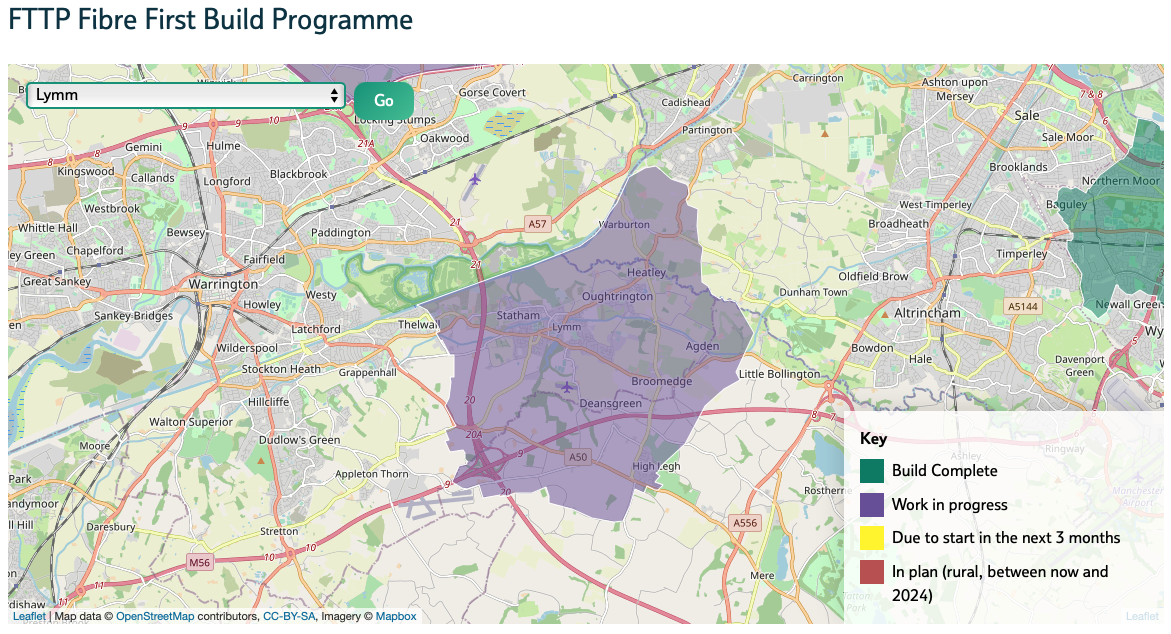
(this map was updated on Lymm.uk in May 2021, with Lymm & surrounding areas moving from "due to start..." to "work in progress" aka changed from yellow to purple - as above, much of Lymm is now complete.
Radio Based Broadband Connectivity ('Fibre to the Mast' or 'FTTM')
Since February 2020, the majority of Lymm and High Legh are able to receive a wireless broadband service from Vispa. This service uses a fibre optic cable installed to a radio mast for the backhaul, with a transmitter / receiver purchased and attached to your house.
Data rates are comparable to FTTC, with pricing slightly higher and an initial setup fee. It appears that to use the service you will have to be 'within range' of the radio mast, likely a reasonably clear line of sight to it. If you are some distance from the Lymm Exchange and FTTC is not available, this is probably the best option, for marginally higher pricing. There is a small chance that the wireless connection could be impacted by weather (lots of rain) and / or trees growing etc, but probably not to an extent that most people would notice.
This would be ideal for people who don't have a FTTC option, or if you really need an internet connection all the time, this would give an alternative internet connection without relying on phone lines / OpenReach (if it's really important then you should check for all single points of failure... as the Vispa solution could use OpenReach back-haul or share power feeds etc.)
Satellite Broadband
This sector is changing rapidly at the moment.
There have been satisfied customers posting in local Facebook groups, suggesting Starlink provides download speeds of ~280Mb/s, upload speeds of ~20Mb/s. Latency should be around 20ms (e.g. good) due to the relatively low orbit used.
Broadband Basics
Lymm Exchange
The Lymm 'telephone' exchange on The Crescent (behind the Shell petrol station) is relevant for some of the available broadband services. You should be able to use the BT Wholesale checker to determine what options you are likely to get to your property (enter phone number + captcha, or address + Captcha though address must be in BT's database, and may be less accurate) - you absolutely don't have to buy from BT & in most cases there will be alternative options at a lower cost / with improved customer services compared to BT. The BT Wholesale checker is recommended over others as it gives a wide range of information about the various options, both for ordering and for fault finding comparison.
"Classic" Broadband (since August 2022 only available where FTTP is not)
Within the Lymm area there were two main options for 'classic broadband', ADSL (Asynchronous Digital Subscriber Line) & FTTC (Fibre To The Cabinet). Both of these are provided via a copper telephone line, that goes from your property to a green street cabinet, and then back to the telephone exchange. The telephone exchange is (keeping it simple) connected to national data networks and the internet.
1. ADSL (Asynchronous Digital Subscriber Line) aka 'Fast' broadband
includes ADSL & ADSL 2+. Typically the cheapest option. Any new installation should be ADSL2+ (giving faster rates than it's predecessor). Data rate received depends the length of the copper wiring to the telephone exchange which can be very different to the actual distance, as cabling can go via some weird routes....
This is now seen as an old technology and is typically no longer on sale to new customers who have other options, though ADSL may still be the only Broadband option for houses that are beyond a certain distance from the Exchange, or whose street cabinets are not enabled for FTTC (see below).
It's likely that lots of properties in Lymm are still on ADSL variants if they have not upgraded to FTTC (below), and would also be paying significantly over the odds for a sub-standard service.
Upgrading from ADSL to FTTC where available should be quick & easy, though typically will involve a new 12 month contract with either the existing provider or a new provider.
2. FTTC (Fibre to the Cabinet), aka 'SuperFast' and 'UltraFast' broadband or 'fibre'
This service currently comes in two rate options - 40/10 & 80/20 - describing the theoretical download & upload speeds e.g. 40/10 FTTC will offer a maximum 40Mbps download rate or speed, probably less than this depending on distance from the cabinet, and a maximum 10Mbps upload rate. For residential FTTC these are badged as:
- SuperFast Broadband up to 40Mbps (FTTC 40/10)
- Superfast Broadband up to 80Mbps (FTTC 80/20)
FTTC 80/20 may not be available to you if you are beyond a certain distance from your street cabinet - more than around 500 - 800 metres of cable route.
FTTC uses fibre optic cable (the preferred, typically 'fastest' option) between the local exchange and your street cabinet and then uses 'VDSL' (Very high frequency Digital Subscriber Line) for the data path over copper cabling from the cabinet to your home. The actual data rate you will get at your house is primarily dependent on the cable distance between your house & the cabinet you are connected to - over about 1km and data rate drops off dramatically - see VDSL distance against speed graph (external link). The quality of the copper cable is also relevant, as is any cable joints, the various copper connection joints along the way, and the type of connection point inside your property.
G.fast (FTTC)
This is a technology that was being pushed until 2018 / 2019 that could provide much higher data rates than FTTC 80/20 to properties within approx 300m of cable length of the street cabinet.
G.fast is available to some cabinets in Lymm (the Seasons estate off Longbutt lane and parts of Rushgreen Road?). Due to the technology and constraints you will either be able to get this, or not.
G.fast is typically sold as "Ultrafast broadband", with speeds of up to 330Mbps down, 50Mbps up, or up to 160Mbps down, 30Mbps up. The faster speeds require properties to have a really short cable length to the street cabinet.
Properties with G.fast available will see the "ultrafast" option available on their ISP's website, when placing an order.
Fibre to the Premises (FTTP)
as above, FTTP has largely replaced ADSL & FTTC for most properties in Lymm since late 2021, with copper phone lines (ADSL & FTTC) becoming obsolete in most cases from 2025. Copper phone lines may be around for longer - they are able to deliver power (and work during a power cut) and are more suited to some specific applications (certain monitoring solutions) than fibre / FTTP lines.
Mobile Broadband (4G and / or 5G)
Pricing varies, reception varies. Usually great in the short term & as a backup but costs can add up on capped data plans, and data rate / quality of service can be very variable.
Some routers have the ability to use a USB 4G dongle to use 4G as a fallback option, though given this requires a specific USB dongle and probably a dedicated SIM card & data plan, it's probably not worth the expense for most people.
Virgin Media Broadband
Virgin Media has been available in parts of Lymm since November 2023. This uses optical fibre typically run along the same routes as OpenReach fibre, & does reach some parts of the village that OpenReach has not yet got to.
Virgin Media offer competitive sign up deals, though their headline rates (e.g. once the deal period expires) seem more expensive than OpenReach equivalents. Some residents are happy with their Virgin Media installations, some that have had issues have had significant issues with VM customer services.
Virgin Media fibre optic services are available in Grappenhall & Thelwall.
Broadband providers
There are a number of options for broadband retailers, who are all purchasing the same wholesale product from OpenReach (they purchase a wholesale ADSL or FTTC connection), connecting this to their own network and adding a service wrap then selling on as a consumer service
There should be very little difference in speeds or reliability between providers - the main differences are:
- customer service
- the hardware - the Wi-Fi access point & broadband router that is 'provided' with the service
- unlimited vs capped monthly data limits (capped services should now be obsolete)
- whether the provider has their own equipment in the cabinet or exchange - Talk Talk and Sky offer an LLU service in Lymm
- UK call centres
- bundled offers such as TV services or mobile phone services
- discounts to new users
- whether the provider offers FTTP, or only offers FTTC / ADSL services - this may be particularly relevant to anyone switching / taking out a new contract during 2021 - not all providers offer FTTP services
Margins in the domestic broadband market are tight, and competition is fairly strong, with a correlation between low prices and poor customer service.
Switching Providers
This section is intended for ADSL and FTTC switching, but the principles should apply for ADSL and FTTC customers switching to FTTP.
(since August 2022, switching providers if you have a copper phone line will almost certainly result in an order for FTTP being raised).
Switching is fairly easy, but not a process that most would want to do very often. If you are having problems with a broadband service, it would be worth trying to determine where the issue is - e.g. the broadband service, your router / wireless access point, or if applicable your wireless reception (details on this below) rather than assuming switching might solve existing problems.
If you are thinking of switching, consider that any email addresses with your current service provider are usually de-activated as you move away, and you are likely to have to set up new Wi-Fi passwords on mobile devices, to connect the wireless router provided with the new service.
If you do switch providers, there is a minimum 10 day lead time to allow your current provider to confirm that you really do mean to switch. Most providers will send out a new wireless modem / router, and passwords to access their broadband service. Due to the new Wi-Fi router, by default your Wi-Fi SSID or 'name' and password will change, though there is nothing to stop you amending the new Wi-Fi SSID and password to that of your old device to avoid having to re-connect all clients.
You will be given a date on which your old service will switch, normally the switch is done automatically with no need for an engineer visit to your property or to the exchange (the exception here is if you are moving services, e.g. ADSL to FTTC). Your service on your 'old' router will stop working, you can then connect the new router and it should be working within around 20 to 45 minutes. If you are moving between the same class of service (e.g. Superfast FTTC / FTTC 40:10 to Superfast FTTC / FTTC 40:10) then speeds and latency should be comparable.
Terms explained
- ADSL (Asynchronous Digital Subscriber Line), ADSL 2+ & ADLS Annex M is marketed as "Fast Broadband", in theory up to approx 20Mbps download rates, though dependent on distance to the Lymm telephone exchange
- FTTC (Fibre To The Cabinet) is marketed as "Super Fast Broadband", available in two tiers, up to 40Mbps (aka "Superfast1") or up to 80Mpbs (aka "Superfast2") download rates, though dependent on distance to the street cabinet.
- FTTP (Fibre to the premises) is marketed as "Ultrafast Broadband", available in download rates from 40Mbps (possibly lower) up to 1Gbps, with no decrease in rates due to distance to the Lymm telephone exchange. FTTP speeds are still asynchronous with lower upload speeds than download speeds.
- Latency, RTT (Round Trip Time), 'ping response' - a measure of how 'responsive' a network connection is, measured by how long it takes a small amount of data (a 'ping' to travel from your house to a remote server, and back. 20ms (milliseconds, or 1/50th of a second) would be 'good' for home broadband (FTTP seems to be stable at around 12ms), over 50-60ms would be 'slow', and possibly indicative of issues. Mobile broadband typically has higher latency than home broadband, with 5G 'faster' than 4G, which is 'faster' than 3G (faster in this context = lower latency). Latency CAN be more important than bandwidth - a low latency 'slow' connection will likely 'feel' more responsive and therefore 'faster' than a 'fast' but high latency connection for typical use (website / social media browsing)